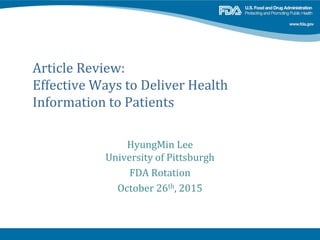
Effective Ways to Deliver Health Information to Patients
- 1. Article Review: Effective Ways to Deliver Health Information to Patients HyungMin Lee University of Pittsburgh FDA Rotation October 26th, 2015
- 2. Objectives Discuss significance of Health Literacy Identify what composes patient preferred patient label Discuss why certain formats increase patient label comprehension Demonstrate the lessons I’ve learned from the project
- 3. A Looming Epidemics 2030 Health Literacy Prediction (Parker et al. ) Blue: National Adults Literacy Survey in 1992 Red: Literacy projection for 2030 • 54% of people will have most basic literacy skill in 2030, compared to 43% in 1992
- 4. Declining Literacy • Failures in Education System – Stagnant H.S. grad rates • Shifting Demographics – New, larger immigrant population • Changing Economy – Growth in knowledge-intensive jobs
- 5. Inadequate Health Literacy and Mortality Age-adjusted survival rate with adequate, marginal and inadequate health literacy. N=3260 (Baker et al. 2007)
- 6. Patient Communication • Consumer Rx materials written 10-11th grade level (Wolf et al., 2012) • Less than one third routinely review (Wolf et al., 2006) • Physicians, pharmacists missing opportunities to counsel patients (Metlay et al., 2005)
- 8. Layouts • Patients preferred Bubble format( 2-column, segmented design) 3,4
- 9. Layout • Avoid visual clutter2 Employ list formats2 Maximize white space2,4 Chunk information into manageable pieces 2 • Use horizontal text only5 • Most common improvement suggestions for prescription auxiliary labels8 – Do not prefer white background (99.2%) – Larger label size needed (85%) – Prefer a picture (58.3%) – Prefer a red, yellow, or green background (31.7%)
- 10. Layouts • Comprehension was significantly greater for all three prototypes 1 • Health literacy form (simple table format) had the most improved patient comprehension1
- 11. Typography • Use clear and simple font2 • Use larger, Sans Serif font5 – Sans (French) = without – Serif (German) = line • Preferred Arialfont to Times New Roman3 – Arial font is “bigger and bolder” than Times New Roman font
- 12. Content • Patient preferred information 6 – Indication for use5,6 – Expected benefits – Duration of therapy – Potential adverse effects – Information identifies the drug’s name – Directions for use – Warnings Topamax 200 mg round, peach, imprinted with TOPAMAX, 200 © Cerner Multum
- 13. Content • Misleading and confusing information3 – Death related sentences • “some people have died from these infections” • One third of respondents indicated such warning discourage them from taking drug. – Separation between “Call Your Doctor” and “Common Side Effects” • Call Your Doctor: ‘pain, chest discomfort, bleeding, swelling… all these things are scary’ • Common Side Effects: Not informative
- 14. Content • Examples of poor interpretation of auxiliary labels 8 Avoid Sunlight (23.3%) Keep medication away from sun Do not chew or crush (14%) Don’t chew but crush Take at bedtime Crush medication before taking Don’t take medication when it’s hot outside Don’t swallow medication whole There are strong drugs; stay away from Sometimes can crush or bite Don’t leave in sun or throw in sun Dissolve medication in liquid Avoid exercise Take medication right away to get in blood stream Be out in sun
- 15. Preference of Content Order3 – For patients with immune disorders and chronic disease, and respondents 50 to 69 years of age, – For general population, and respondents younger than 50 years and those 70 years of age or older Content Order Directions for Use Important Warning
- 16. Language - Encouraged • Use concrete2,explicit, active4 , simple 4,8 , and concise8 language • Stick to positive wording 2,4. – Negation in statement can hinder memorization – Older readers are more likely to misremember negatively worded health guidelines • Use numeric 5 – Drug dose, concentration, and frequency • Six-grade reading level 8 • Avoid medical jargon5
- 17. Medication Information Distribution Pathways • In pharmacy in paper and electronic formats • Online via email or other electronic method (QR code) • Sent to patient in electronic health record Pearsall, Bryon. “Patient Medication Information.” Exploring the Promise of Patient Medication Information. The Brooking Institute. Washington, DC. July 1st, 2014. Presentation
- 18. Near Field Communication (NFC) • “NFC-Enabled Cellphones Shipments to Soar Fourfold in Next Five Years” – IHS 2014 • https://www.youtube.com/watch?v=EdyIP7yqWJY – 18.2% in 2013 64.0% in 2015 lisinopril
- 19. Thank You
- 20. References 1. Wolf et al. Comparative Effectiveness of Patient-centered Strategies to Improve FDA Medication Guides. Medical Care; 2014; 52:781-789 2. Wilson et al. Working memory and the design of health materials: A cognitive factors perspective. Patient Education and Counseling 74 (2009) 318–322 3. Kish-Doto et al. Preferences for Patient Medication Information: What Do Patients Want? Journal of health communication, 19(sup2), 77-88. 4. Boudewyns et al. Influence of patient medication information format on comprehension and application of medication information: A randomized, controlled experiment. Patient Education and Counseling (2015) 5. Bailey et al. Advancing best practice for prescription drug labeling: an updated literature review. Annals of Pharmacotherapy 1-15, 2015 6. Bosworth et al., Medication Adherence: A call for action; review article. Am Heart J 2011; 162:412-24. 7. Lindquist et al. Unnecessary complexity of home medication regimens among seniors. Patient Education and Counseling 96 (2014) 93-97 8. Locke et al. Improving prescription auxillary labels to increase patient understanding. J Am Pharm Assoc. 2014; 54:267–274. 9. Yin et al. Unit of Measurement Used and Parent Medication Dosing Errors. Pediatrics Vol 134, No. 2: e354-361; Aug 2014. 10. Smith et al. Reducing drug self-injection errors: A randomized trial comparing a "standard" versus "plain language" version of Patient Instructions for Use. Research in Social and Administrative Pharmacy. 9, 621-625.
